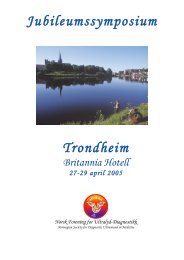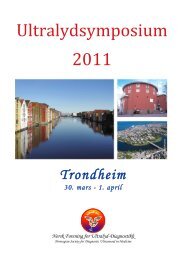Abstrakter - NORSK FORENING FOR ULTRALYD-DIAGNOSTIKK
Abstrakter - NORSK FORENING FOR ULTRALYD-DIAGNOSTIKK
Abstrakter - NORSK FORENING FOR ULTRALYD-DIAGNOSTIKK
Create successful ePaper yourself
Turn your PDF publications into a flip-book with our unique Google optimized e-Paper software.
A simulation study of SURF reverberation suppression in an aberrating<br />
medium<br />
Peter Näsholm, Halvard Kaupang, Svein-Erik Måsøy, Rune Hansen and Bjørn<br />
Angelsen<br />
Department of Circulation and Medical Imaging, Norwegian University of Science<br />
and Technology, Trondheim, Norway<br />
Introduction:<br />
A numerical computer simulation study is presented in the form of a film showing<br />
the shapes of transmit ultrasound pulses propagating through an heterogeneous body-<br />
wall. The purpose is to evaluate the feasibility of SURF reverberation (multiple<br />
scattering) suppression when a strongly heterogeneous body-wall is present within<br />
the path of the wave-propagation. The study also compares the synthetic propagating<br />
SURF wave to a standard fundamental imaging wave propagating within the same<br />
medium. The study is important because the body-wall of a patient, where standard<br />
fundamental ultrasound imaging is aggravated due to reverberation noise, also is<br />
likely to produce propagation time-shifts due to aberration (spatially varying speed<br />
of sound). Aberration causes a local defocusing of the beam, and is known to reduce<br />
contrast and lateral resolution. SURF imaging reverberation suppression is based on<br />
a synthetic beam generation where the synthetic beam is dependent on small time-<br />
shifts arising from the non-linearity of the medium and interaction with a low-<br />
frequency manipulation pulse transmitted simultaneously as the HF imaging pulse. If<br />
the time-shifts introduced by aberration heavily distort the time-shifts needed for<br />
adequate SURF synthetic beam generation, the reverberation suppression gain of the<br />
SURF imaging method is no longer present.<br />
Method:<br />
The simulations performed has been for an annular array transducer with 14.2 mm<br />
aperture focused at 82 mm. For the fundamental imaging scheme, the frequency was<br />
3.5 MHz and for the SURF scheme the imaging frequency was 3.5 MHz with a 0.5<br />
MHz manipulation pulse. The low frequent manipulation is transmitted from an<br />
aperture with 20 mm diameter, but through the same surface as the high frequency.<br />
The body wall model is 39 mm thick and is eqvivalent to a strongly aberrating<br />
abdominal wall.<br />
Results, discussion and conclusion:<br />
Results show that both the generation of synthetic SURF reverberation suppression<br />
imaging transmit beams is attainable, even though the modeled body-wall is<br />
estimated to yield more severe aberration than estimated from real human body-wall<br />
specimen. Reverberation noise is caused by scattering within the body-wall, and the<br />
slow build-up of the SURF beam within the body-wall causes the beam to be less<br />
sensitive to reverberation noise. The fundamental beam is on the other hand<br />
generated from one single pulse, and maintains a high intensity through the body-<br />
wall and is because of this more sensitive to reverberation noise generated by a first<br />
scattering within the body-wall.<br />
40











